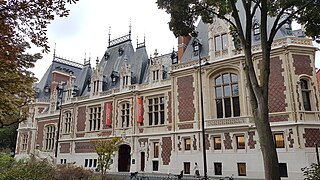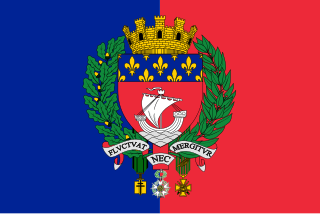
The Rue de Rivoli is a street in central Paris, France. It is a commercial street whose shops include leading fashionable brands. It bears the name of Napoleon's early victory against the Austrian army, at the Battle of Rivoli, fought on 14–15 January 1797. Developed by Napoleon through the heart of the city, it includes on one side the north wing of the Louvre Palace and the Tuileries Gardens.

The 17th arrondissement of Paris is one of the 20 arrondissements of the capital city of France. In spoken French, it is referred to as le dix-septième.

Palais Royal–Musée du Louvre is a station on Line 1 and Line 7 of the Paris Métro. Situated in the heart of the 1st arrondissement, it most notably serves the Palais-Royal, Comédie-Française and Louvre.

Pont Marie is a station of the Paris Métro opened in 1926 with the extension of Line 7 from Palais Royal–Musée du Louvre. It is named after the nearby bridge over the Seine, the Pont Marie, which connects to Île Saint-Louis.

The Palais-Royal is a former French royal palace located on Rue Saint-Honoré in the 1st arrondissement of Paris. The screened entrance court faces the Place du Palais-Royal, opposite the Louvre. Originally called the Palais-Cardinal, it was built for Cardinal Richelieu from about 1633 to 1639 by architect Jacques Lemercier. Richelieu bequeathed it to Louis XIII, before Louis XIV gave it to his younger brother, Philippe I, Duke of Orléans. As the succeeding Dukes of Orléans made such extensive alterations over the years, almost nothing remains of Lemercier's original design.

Louis Tullius Joachim Visconti was an Italian-born French architect and designer.

Pierre Contant d'Ivry, was a French architect and designer working in a chaste and sober Rococo style and in the goût grec phase of early Neoclassicism.

Pierre-Louis Moreau-Desproux was a pioneering French neoclassical architect.

The Rue Saint-Honoré is a street in the 1st arrondissement of Paris, France. It is named after the collegial Saint-Honoré church, situated in ancient times within the cloisters of Saint-Honoré.
The Théâtre des Variétés-Amusantes was a theatre company in Paris.
The Rue Rambuteau is a street in central Paris, France, named after the Count de Rambuteau who started the widening of the road prior to Haussmann's renovation of Paris. The philosopher Henri Lefebvre lived on the street and observed from his window the rhythms of everyday life at the intersection located behind the Centre Georges Pompidou.
Joseph-Henri Deverin (1846-1921) was a French architect and urban planner. He was the chief architect of historic monuments.
This article presents the main landmarks in the city of Paris within administrative limits, divided by its 20 arrondissements. Landmarks located in the suburbs of Paris, outside of its administrative limits, while within the metropolitan area are not included in this article.

The Petit Luxembourg is an hôtel particulier and the official residence of the President of the French Senate. It is located at 17–17 bis, Rue de Vaugirard, just west of the Luxembourg Palace, which serves as the seat of the Senate, in the 6th arrondissement of Paris. Originally built around 1550 to the designs of an unknown architect, it is especially noted for the surviving Rococo interiors designed in 1710–1713 by the French architect Germain Boffrand. Further west, at 19 rue de Vaugirard, is the Musée du Luxembourg.
Events from the year 1665 in France.

The following outline is provided as an overview of and topical guide to Paris:

The Rue de Beaujolais is a street in the 1st arrondissement of Paris, France.

The Rue de Valois is a street in the Palais-Royal quarter in the 1st arrondissement of Paris, France.













